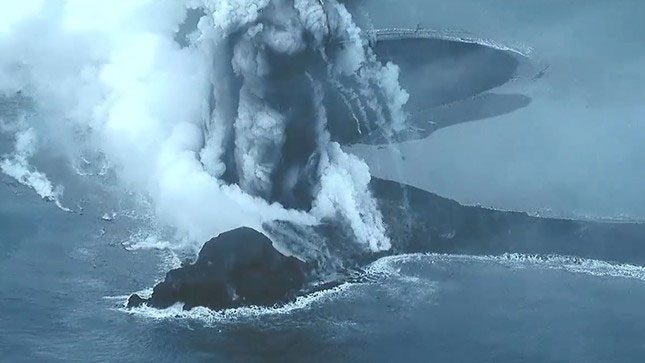A recent underwater volcano has formed a new island in the Pacific Ocean, which has erupted again, sending clouds of ash and smoke into the sky, according to footage released by the Japan Coast Guard.
The volcano is located off the coast of Iwo Jima, Japan, south of the Izu-Ogasawara arc, and had previously erupted on October 21. Increased activity in the following days led to recorded explosions by October 30. Each explosion hurled rocks and ash into piles growing larger about 1 km offshore from the island, ultimately forming a volcanic promontory named Niijima, which means “new island” in Japanese.

The Japan Coast Guard captured aerial footage of the recent eruption near Iwo Jima. (Photo: Japan Coast Guard)
Niijima is now visible from space, as revealed by satellite images taken by the European Space Agency on November 3. The new land measures 100 meters wide with its highest point reaching 20 meters above sea level. The October eruption has since subsided, but scientists indicate that waves may soon erode Niijima.
However, a new eruption has shaken this young island, the Japan Coast Guard announced on November 27.
“According to observation results, eruptive activity has been detected on Niijima off the coast of Okinahama on the southern shore of Iwo Jima,” representatives stated in a post on X.
The eruption on November 23 sent ash and smoke soaring up to 200 meters into the sky. Aerial footage shows a significant volcanic explosion, with rocks and other debris falling into the sea from a cloud of black smoke. The wind appeared to be blowing smoke and ash in one direction as waves crashed against the island’s shore.
Recent eruptions indicate that volcanic activity is returning in the waters surrounding Iwo Jima after a brief period of quiet following the July 2022 eruption.
It remains unclear how the latest eruption will impact the existence of the newly formed island Niijima. However, whether the island remains intact depends on the type of rock formed, experts say. If it is made of lava, Niijima may have a chance of survival.
Iwo Jima and Niijima sit atop a chain of underwater volcanoes along the Pacific Ring of Fire.
The Ring of Fire—stretching from the southern tip of South America, along the western coast of North America, through the Bering Strait, down through Japan, and all the way to New Zealand—is the most seismically and volcanically active region in the world.



















































